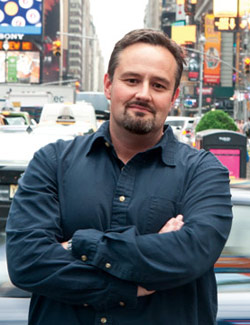Summer 2014
 In the rough-and-tumble world of New York production, Eric Henriquez credits an early mentor—1st AD Joseph P. Reidy (Martin Scorsese’s right-hand man for nearly 30 years)—with setting the template for the kind of assistant director he wanted to be.
In the rough-and-tumble world of New York production, Eric Henriquez credits an early mentor—1st AD Joseph P. Reidy (Martin Scorsese’s right-hand man for nearly 30 years)—with setting the template for the kind of assistant director he wanted to be.
“I was fortunate to be a DGA trainee on Donnie Brasco (1997) and The Horse Whisperer (1998),” Henriquez recalls. “I was amazed at how thoughtful and considerate Joe was in his daily work, while still commanding the loyalty of his crew. He treated everyone with such respect, so if Joe ever got upset, you knew it was a really big problem.”
Henriquez made the permanent jump to 1st AD during the final season of The Sopranos. “I was involved with killing off so many iconic characters on that show,” he laughs. “I remember shooting out at sea near Miami, with James Gandolfini and Tony Sirico. I didn’t have any problems with seasickness, but most everyone else did. James would do a take, and then lose it over the side of the boat after cut, and then do it all over again. It went on like that for a few hours and I was one of the few people on the boat standing upright the entire time.”
For David Simon’s The Wire, where Henriquez spent four seasons, both cast and crew became a nimble and efficient production unit. “Every episode featured, literally, dozens of characters in many real [Baltimore] locations,” Henriquez recounts. “We could only work with the bare minimum crew—trucks, grip and electric, and camera. Even the cast knew they had to hit their lines the first time.”
Treme, shot mostly in that colorful New Orleans neighborhood, was another series that challenged Henriquez in every way. “Scheduling was so complex, because so much of the story was told through real musicians in real New Orleans venues,” he remembers. “But musicians don’t get up before 2:00 p.m., and that’s when the venues, which were booked at night, were available. For me that meant being very creative making up time lost for company moves.”
Steering a visually uncompromising TV series through New Orleans’ unpredictable streets was a skill that served Henriquez well when American Horror Story relocated there from the Paramount lot in Hollywood. “It’s a show heavily reliant on prosthetic makeup and visual effects,” he explains. “At first, the crew panicked because they thought they’d have to compromise quality to the point where the show would not be recognizable. But coming from Treme, I knew it could be done.”
One example was an elaborate “zombie attack,” where barn walls were torn down and internal organs ripped out and flung around. “We found an amazing family cemetery up the street [from the barn location],” says Henriquez. “But, due to the storyline, it was impossible to have two separate zombie units.
“So I spent an incredible amount of time planning how to use the same zombies in both locations, and everything turned out great. By the end of the season, I think the show embraced the city’s texture and production values. I feel good that I played some part in that.”